Playing through the pain: Maybe it's time for an 'Earnhardt Rule'
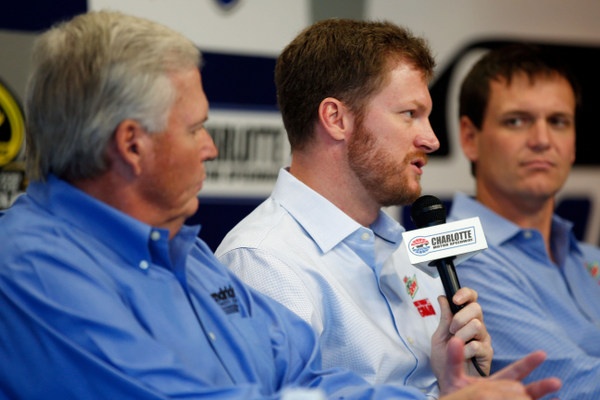
Dale Earnhardt Jr., explaining his thinking about concussions (Photo: Getty Images for NASCAR)
(Updated)
By Mike Mulhern
mikemulhern.net
CONCORD, N.C.
Upon further review....it's time for some fresh thinking in this sport about safety and head injuries and medical policies.
The Dale Earnhardt case should be a wakeup call.
NASCAR shouldn't force drivers to race hurt.
Period.
Man-up?
Or Playing Stupid?
It's your head....
It's time for NASCAR to add a safety rule that allows drivers, when injured, to sit out a race or two until they heal up.
A medically mandated driver substitute.
Call it the Earnhardt Rule.
And it's long, long, long overdue.
A driver and his team shouldn't be penalized if the driver is banged up too hard and needs to sit on the bench for a few days.
No driver should be forced to chose between his health and his team's playoff hopes and championship dreams.
Remember when Dale Earnhardt Jr., in 2002, suffered a concussion in an April crash at California Speedway but didn't tell anyone until September, when he revealed he was "loopy" from that crash until July?
Remember when Mark Martin was so badly hurt that he had to be lifted into his race car, so he could run enough laps to get championship points?
Remember Ricky Rudd taping his Daytona-swollen eyes open so he could race the following week at Richmond?
Remember Richard Petty racing with a broken neck?
Heck, remember Brad Keselowski racing just last year with a badly broken foot....
The sport's history is filled with examples of drivers racing while injured/impaired. For 'valuable points' usually.
Too much 'You've got to be kidding me...'
Maybe that was okay at one time.
Maybe it's not so okay now.
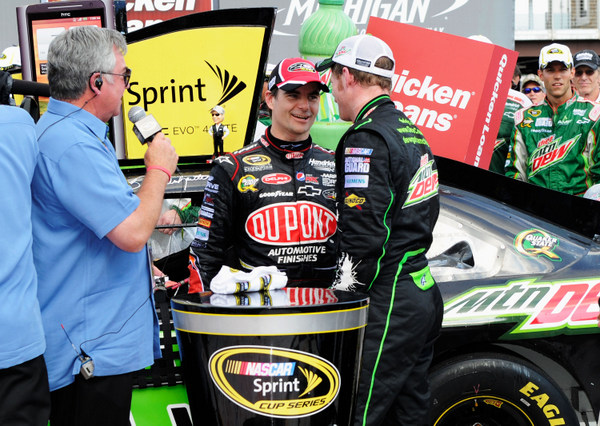
The good times..... (Photo: Getty Images for NASCAR)
For decades, since sometime back in the 1950s, when team owner Carl Kiekhaefer mixed-and-matched drivers, to win back to back championships and 55 races, angering Bill France Sr. greatly, the sport has had a pretty hard-and-fast rule: driver championship points only go to the man who actually starts the car in the race.
It's a rule long, long outdated.
It's time to change that rule.
And the reason is obvious:
Dale Earnhardt Jr. suffered a concussion in a hard crash while testing tires Aug. 29th at Kansas Speedway. He hit the wall at maybe 205 mph when his right-front blew.
Drivers testing with him say it was clearly a very hard hit.
Earnhardt realized it was a very hard hit, and he even told crew chief Steve Letarte the team needed a backup plan in case Earnhardt didn't feel up to starting the Atlanta 500.
However if Earnhardt didn't start the Atlanta and Richmond races, he would have lost maybe 68 points, and possibly missed the playoffs.
A corollary to this is that NASCAR's system of two championships, a driver's championship and an owner's championship, is also outdated. This is a team sport, and the championship should recognize that. How NASCAR got into this weird dilemma probably goes back to that 1969 issue at Talladega....
In the National Football League, there is no quarterback's championship. If the quarterback is injured and has to sit out a game or two, the team still gets credit for wins with the backup quarterback. Why should NASCAR racing be any different?
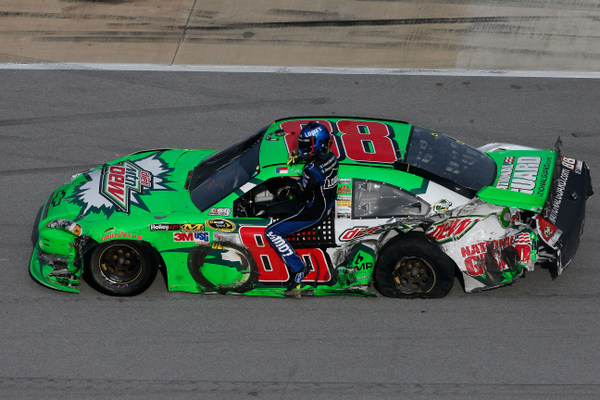
And the bad times (Photo: Getty Images for NASCAR)
NASCAR didn't realize the extent of Earnhardt's injuries. He wasn't even taken to the infield care center at Kansas, just examined by a doctor in the ambulance.
A 40-G hit.
Earnhardt concedes he was only 80 or 90 percent for a while after that hit.
He says he felt back to 100 percent for the start of last weekend's Talladega 500.
A 20-G hit the last lap, in that wild 25-lap crash. Just enough to put Earnhardt back over the medical edge.
Another concussion.
Again NASCAR didn't realize the extent of Earnhardt's injuries. Again he wasn't even taken to the infield care center.
Two concussions in just six weeks, and only Earnhardt knew.
NASCAR shouldn't put drivers in that dilemma.
And each concussion, whether it's in the NFL, NASCAR or your own backyard, increases the susceptibility for another concussion. Lowers the threshold level.
Anyone who talked with Neil Bonnett that day at Talladega, when he decided to step out of his ride because he couldn't even recognize his wife.....
And Dr. Jerry Petty, the Charlotte neurologist who is frequently brought in to assess NASCAR injuries, says 90 percent of the time the only way to diagnose a concussion is by listening to complaints from the driver.
By the time a head injury shows up on an MRI, Petty says it is far beyond a concussion, and into something much more serious, like hematoma.
It's time for some fresh thinking....
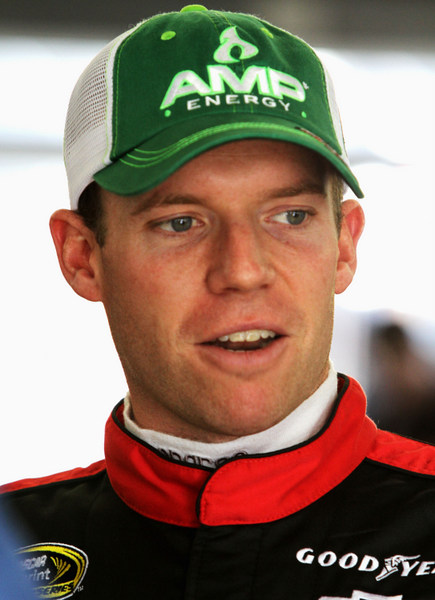
Regan Smith: big shoes to fill (Photo: Getty Images for NASCAR)
Earnhardt himself hid the severity of the August concussion until just a few days ago. And he hid the severity of the Talladega hit until this week too.
NASCAR never knew, doctors never knew, until Earnhardt told them.
"I didn't see anybody at Kansas," Earnhardt said, referring to his not getting a post-crash examination. "I regret not seeing somebody after that happened.
"I was stubborn, and I'd had concussions before, and knew what I was.... thought I knew what I was dealing with. And felt I was capable of doing my job."
Well, not quite.
"I called Steve... We talked about how I was feeling... and I told him that I really felt pretty good, but I really wouldn't know if I would be able to compete until I got into the car (at Atlanta).
"When you have a concussion, the symptoms can be really mild, and then they'll typically go away after a couple days and you feel perfectly normal.
"But when you get in a car and go around the track at a high rate of speed, you start to understand that some things just aren't quite where they need to be, some reactions just aren't as sharp.
"You really can't get a measurement of that until you're in the car.
"(But) I wasn't willing to, with the chase coming up, (to take himself out of the car)."
Why?
"If I was to volunteer myself to medical attention and be removed from the car, I didn't know how difficult it would be to get back in," Earnhardt said.
"But I was honest with Steve: 'When we get to Atlanta, if I don't feel good, I'm going to be honest with you and tell you that we need to have something as a backup plan for me to get out of the car.'
"I wasn't going to drive the car if I felt like I was going to deal my crew chief and my team a short hand that weekend."
It's time for some fresh thinking....
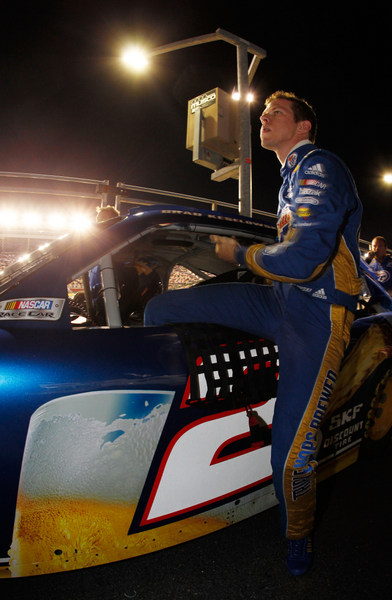
Brad Keselowski (Photo: Getty Images for NASCAR)
Drivers are generally loath to talk about such injuries. 'There but for the grace of God...'
And the idea of having to sit out a race is anathema.
Jeff Gordon put it bluntly. If he were leading the championship race down the stretch and got a concussion and knew he wasn't quite right, he wouldn't tell anyone: "Honestly, I hate to say this, but no, I wouldn't.
"If I have a shot at the championship, two races to go, my head is hurting, and I just came through a wreck, and I am feeling signs of it, but I'm still leading the points, or second in the points, I'm not going to say anything. I'm sorry."
Playing with pain may be a sports mantra, but sometimes it's just plain dumb.
Keselowski was at Kansas when Earnhardt crashed: "He wrecked really hard. I was there when it happened. I was physically there and literally right next to him when it happened.
"He had wrecked; I had heard it in my car.
"We were sitting in the garage and I looked up and could see the marks and knew that he had hit really, really hard, and that he was probably not going to be okay.
"I drove out where they were cleaning up the car and looked at the marks and again thought 'Wow, he hit really, really hard.'
"I drove by him right when he was getting out of it and picked him up. He sat next to me and I drove him back to his hauler...and he looked fine to me.
"I was really impressed by the fact that he looked as well as he did, because I would have been really, really sore.
"Only he knows where it went from there....
"I have to trust him. A large portion of the sport is based on trust... and that's why it's such a tight-knit community."
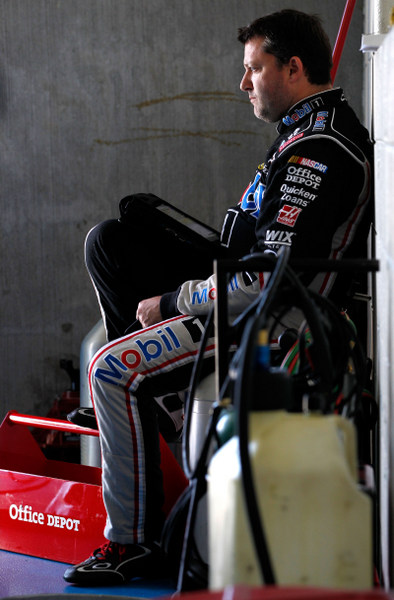
A pensive Tony Stewart (Photo: Getty Images for NASCAR)
Playing through the pain....
Keselowski, when he first learned Thursday morning that Earnhardt was taking himself out of Saturday night's Charlotte 500 because of those two concussions, said "I was as shocked as anyone to hear that stuff.
"It's a tough situation to race in this sport, to be under injury, and be wondering what the line is.
"We all have our own code for that."
Duty to team, Keselowski says, is sometimes a big factor in what a driver decides to do: "to persevere through adversity and physical injury...
"But then you're balancing that...Sometimes you can compete through an injury and perpetuate whatever damage there is... or even worse, risk those around you.
"There is certainly a fine line to walk. And every injury is different.
"But every driver will encounter that at some point in their career and has to find his own path through it.
"For any driver, not being in the car is your worst fear. It's the nightmare you have.
"I have the nightmare where you wake up late, they drop the green, and you're not in the car yet."
But racing with a concussion, perhaps a bad concussion....
Just leaving the call up to the driver obviously isn't the best way for NASCAR to handle this situation.
"I'm not a doctor but I do have a loose understanding of what a concussion is," Keselowski says. "It comes to what severity, and how it affects your performance.
"Basically it's treated off symptoms, and there's hardly any way to prove -- without it being a severe concussion -- whether you have one or not.
"I have never had a concussion that was able to be medically proved.
"I've had concussions that a doctor could look at you and say 'I think you do, based off what you're telling me.'
"The brain is a very complex part of the body...
"If you're saying 'Brad, have you had a concussion?' I want to see a picture that says 'Yeah, there's a bruise, there's a blotch.'
"That's a concussion to me, one that I can prove."
However Keselowski concedes there is "the middle ground...where you feel sick but you can't prove anything medically.
"That's where it becomes tough. I've had situations where I've been in that middle ground, and you're left going off your gut.
"Dale chose to not put himself in a bad situation. And that's very admirable, because everyone knows those are cumulative, concussions and their effect on your body, and that's something he doesn't need to take a risk of.
"I feel drivers in this sport are smart enough to know the line. And usually if you have an injury like that, that prevents you from being focused and racing at 100 percent.
"The sport almost naturally clears itself of people like that."
But Keselowski adds "Only you know how bad they are.
"Everyone has their own code. That's the tricky thing about concussions -- You can't just look at somebody like a broken arm because you can see a broken arm.
"You can't just look at somebody and say 'Well, he's got one,' or 'He doesn't.'
"So it's very much self-policed."
That is simply unfair....to the driver himself, to his fellow drivers, and to the sport itself.
It's time for some fresh thinking.
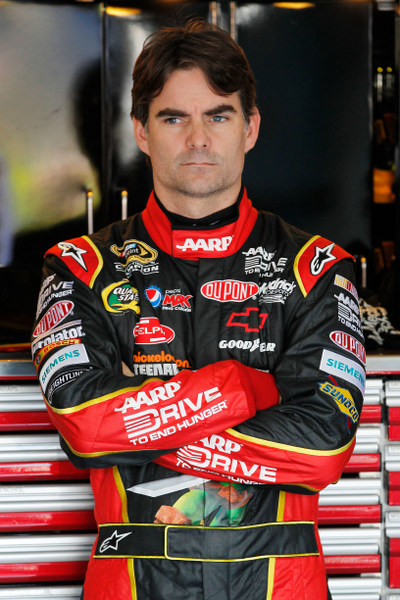
Jeff Gordon (Photo: Getty Images for NASCAR)
© 2010-2011 www.mikemulhern.net All rights reserved.
Web site by www.webdesigncarolinas.com







You are my favorite NASCAR writer and you have
You are my favorite NASCAR writer and you have written many excellent articles. That being said, this may be the most important article you have ever written. Thanks.
Reply to comment
There's no reason Nascar couldn't allow for a
There's no reason Nascar couldn't allow for a 'relief driver' in case of a driver injury. By eliminating the possibility for points, they are encouraging drivers to drive with a concussion, which could be life altering for them. Seems like it would be enough of a handicap for a team to have to bring in a substitute driver to offset any advantage that they can stay 'in the hunt'.